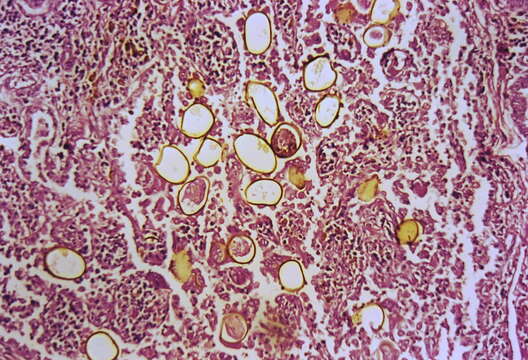Paragonimiasis - Case 285

Description:
Description: Paragonimiasis is caused by the lung fluke Paragonimus westermani which is most prominent in Asia and South America. Infection in humans is contracted by the ingestion of a crab or crayfish harboring the metacercariae. The metacercariae excyst in the small intestine and penetrate the intestinal wall gaining entrance to the peritoneal cavity and are then able to penetrate the diaphragm and invade the lungs where they develop into adults.The adult worms usually become surrounded by a fibrous capsule but they may also inhabit the airways. Ova are coughed up and either expectorated or swallowed and then excreted. If the ova find their way into water the miracidia emerge from the ova which may then be ingested by a suitable snail. Cercariae leave the snail and then invade a crab or crayfish where they develop into metacercariae, the infective stage for humans. This image shows numerous large, yellow ova with a thick outer rim located within the lung parenchyma. Contributed by Philip Kane, MD. Date: 21 March 2014, 16:53. Source: Paragonimiasis - Case 285. Author: Yale Rosen from USA.
Included On The Following Pages:
- Biota
- Eukaryota (eukaryotes)
- Unikonta
- Opisthokonta (opisthokonts)
- Distaplia
- Filozoa
- Apoikozoa
- Animalia
- Eumetazoa
- Bilateria
- Protostomia (protostomes)
- Platyzoa
- Platyhelminthes (flatworms)
- Trematoda (flukes)
- Digenea (Parasitic Flatworms)
- Plagiorchiida
- Paragonimidae
- Paragonimus
This image is not featured in any collections.
Source Information
- license
- cc-by-sa-3.0
- copyright
- Yale Rosen
- creator
- Yale Rosen
- source
- Flickr user ID pulmonary_pathology
- original
- original media file
- visit source
- partner site
- Wikimedia Commons
- ID


